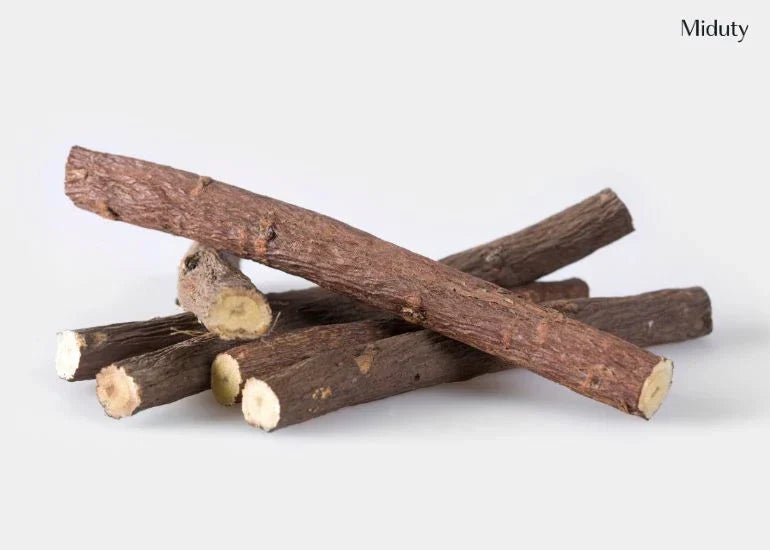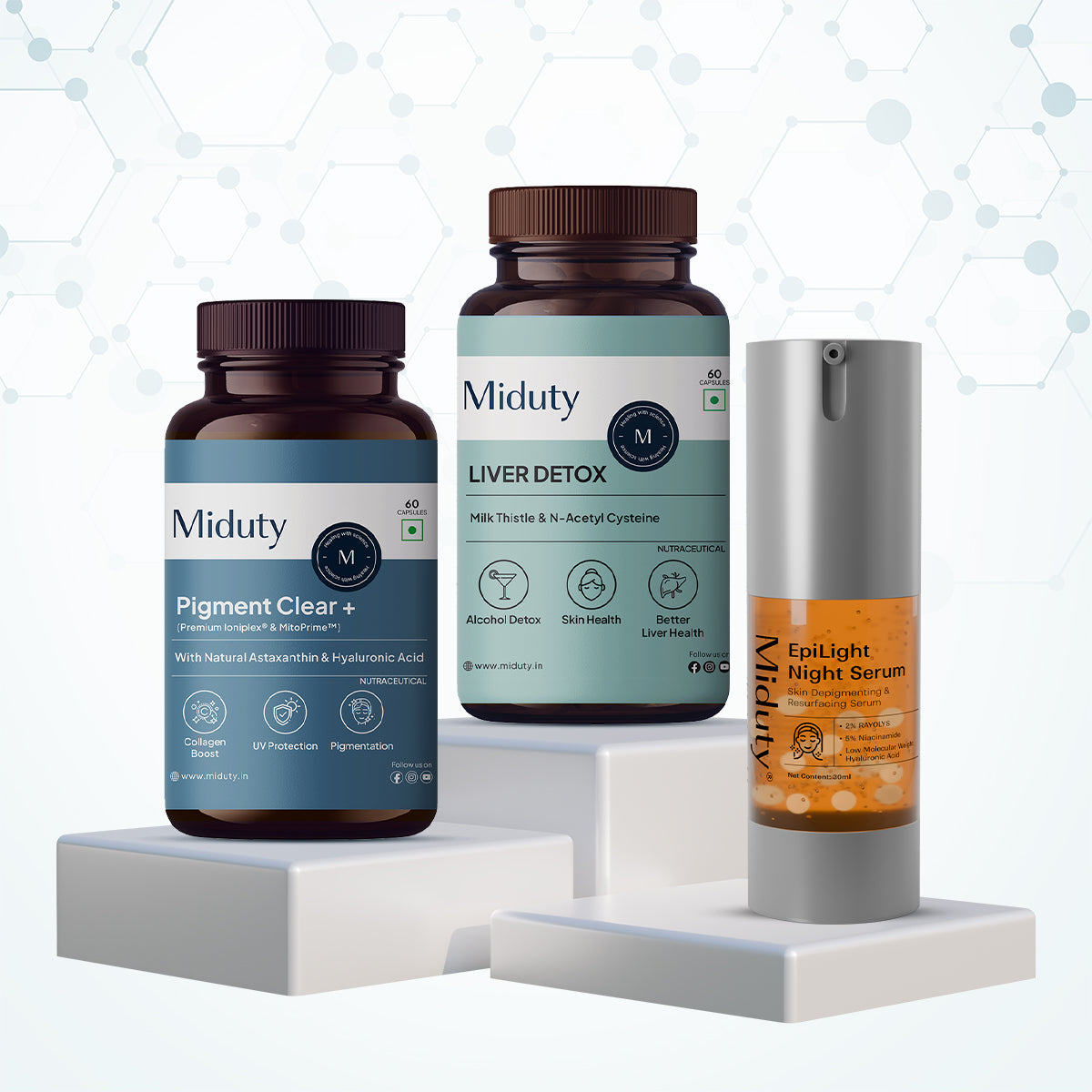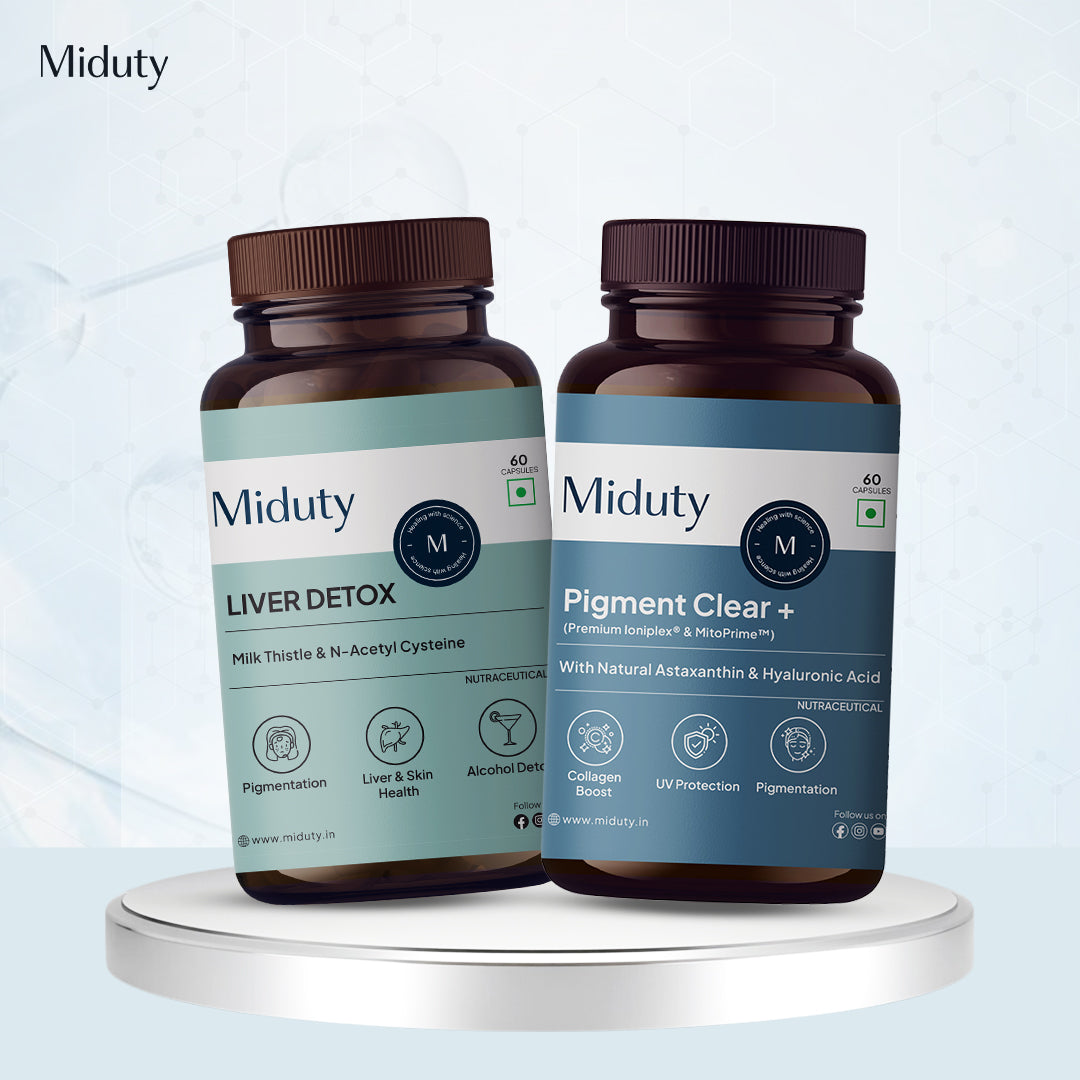
Top 6 Benefits of Licorice Root for Healthy Skin
If you're tired of using harsh skincare ingredients that irritate your skin more than they help, it might be time to turn your attention to something gentler and incredibly effective like licorice root extract. Licorice isn't just a sweet treat; it's a powerhouse herbal remedy with anti-inflammatory, antioxidant, brightening, and anti-aging benefits for your skin.
From ancient remedies to modern skincare formulations, licorice has been celebrated for centuries for its healing and rejuvenating powers. Whether you're struggling with acne scars, sun spots, dullness, or irritation, licorice might just be the ingredient your skincare routine is missing.
Key Takeaways
1. Licorice Can Brighten Skin as Effectively as Hydroquinone. One of licorice's active compounds, glabridin, works like a natural skin lightener by blocking melanin production. similar to hydroquinone, but gentler and safer for long-term use.
2. It's Nature's Cortisone (Without the Steroid Risks!) Glycyrrhizin in licorice mimics the anti-inflammatory effects of corticosteroids, helping to soothe eczema, redness, and rashes without thinning your skin like steroid creams do.
3. Hidden Hero in K-Beauty and Dermatology Serums. Many top Korean and Western skincare brands sneak licorice into their formulas to boost glow, even tone, and repair sun damage, but it rarely gets the spotlight it deserves
4. Acts Like a Natural UV Shield for Your Skin. Licorice doesn't just fade sunspots, it also contains compounds like licochalcone A that help protect skin from UV-induced damage, making your sunscreen work even harder.
5. Licorice Helps Control Oil While Hydrating Dry Patches. Sounds impossible, right? But licorice is uniquely balanced: it can regulate oily skin while also repairing the moisture barrier, making it ideal for combination and acne-prone skin.
What is Licorice Root?
Licorice root, scientifically known as Glycyrrhiza glabra, is a plant native to parts of Europe and Asia. It's widely recognized in Traditional Chinese Medicine, Ayurveda, and Western herbalism for its therapeutic benefits. The root contains over 300 different compounds, but in skincare, the spotlight shines on glycyrrhizin, glabridin, liquiritin, and licochalcone A.
Each of these components contributes something unique—whether it's calming inflammation, lightening hyperpigmentation, or fighting free radicals. What makes licorice especially amazing is that it offers all these perks without being too harsh, making it suitable for sensitive and acne-prone skin.
Top Benefits of Licorice for Skin
Licorice root extract has been valued for centuries in traditional medicine, and today it's a star ingredient in modern skincare. Backed by research, it offers a wide range of benefits — from brightening dark spots to calming sensitive skin. Here's how licorice works for healthier, radiant skin:
1. Brightens Skin and Reduces Pigmentation
Licorice is a natural alternative to harsh chemical brighteners, helping fade unwanted marks gently and effectively.
- Inhibits Tyrosinase: By reducing the activity of tyrosinase, an enzyme responsible for melanin production, licorice helps lighten dark spots, melasma, and acne scars.
- Glabridin – The Natural Brightener: This bioactive compound blocks melanin formation, reducing hyperpigmentation and sunspots.
- Liquiritin – Fades Existing Pigment: Unlike most lightening agents, liquiritin not only slows pigment production but also breaks down and disperses existing pigmentation, making it especially effective for post-acne marks and age spots.
- Gentle Yet Safe: Unlike hydroquinone, licorice is non-irritating and safe for long-term use, even on sensitive skin.
2. Calms Inflammation and Redness
Licorice contains soothing compounds that make it ideal for irritated, inflamed, or reactive skin.
- Glycyrrhizin for Comfort: This compound mimics cortisol-like activity, helping calm redness, swelling, and itchiness.
- Supports Sensitive Skin: Perfect for conditions such as eczema, rosacea, dermatitis, and even irritation from over-exfoliation.
- Licochalcone A: Provides anti-inflammatory action that relieves discomfort and restores balance.
3. Fights Acne and Controls Oil
Beyond brightening, licorice is a great ally for oily and acne-prone skin.
- Antibacterial Benefits: Licorice helps fight acne-causing bacteria (Propionibacterium acnes), reducing breakouts.
- Sebum Regulation: Licochalcone A helps balance oil production, preventing clogged pores and excess shine.
- Post-Acne Healing: Not only does it calm active acne, but it also fades the scars and pigmentation left behind.
4. Antioxidant and Anti-Aging Power
Licorice extract is packed with antioxidants, which makes it a powerful defender against premature aging.
- Neutralizes Free Radicals: Helps fight oxidative stress caused by UV rays, pollution, and lifestyle factors — reducing fine lines and wrinkles.
- Boosts Collagen and Elastin: Encourages skin regeneration, leading to firmer, smoother, and more youthful skin.
5. Protects Against Sun Damage
While licorice cannot replace sunscreen, it offers an extra layer of defense and helps the skin recover from UV exposure.
- Shields from UV Stress: Compounds like glabridin and licochalcone A help reduce UVB-related skin damage.
- Repairs and Heals: Aids in treating sunburn, redness, and pigmentation caused by overexposure.
- Works with Sunscreen: Pairing licorice-based products with sunscreen enhances overall sun protection.
6. Strengthens the Skin Barrier and Boosts Hydration
Licorice not only brightens and protects but also improves overall skin resilience.
- Prevents Moisture Loss: Enhances the skin's lipid barrier, reducing transepidermal water loss.
- Heals Dryness: Glycyrrhizin soothes dry patches, cracked skin, and irritation, making it especially helpful for eczema and windburn.
- Supports Long-Term Skin Health: By reinforcing the barrier, licorice helps maintain soft, supple, and well-hydrated skin.
Licorice extract is a multitasking skincare ingredient that addresses pigmentation, acne, sensitivity, and early signs of aging — all while being gentle enough for everyday use. Whether you want to brighten dark spots, calm irritation, or protect your skin from environmental stressors, licorice is a natural powerhouse worth adding to your routine.
How to Use Licorice in Your Skincare Routine?
Adding licorice to your routine is easy and effective when done right.
Look for These Forms:
1. Serums: Great for targeted treatment of dark spots and acne scars.
2. Toners: Good for balancing skin tone and calming inflammation.
3. Moisturizers: For long-term hydration and barrier support.
4. Face Masks: Occasional use for a quick brightening boost.
DIY Option (With Caution)
You can create a DIY licorice mask by mixing licorice root powder with honey or aloe vera gel. However, make sure to patch test first to avoid irritation.
Who Should Avoid Licorice?
While licorice is generally considered safe and well-tolerated—especially when used topically in skincare—there are a few cases where caution is needed:
1. Pregnant women: High doses of licorice, particularly in oral supplements, may pose risks during pregnancy. Licorice root contains glycyrrhizin, which in large amounts can affect hormone balance and blood pressure. Skincare products with licorice extract are typically much milder, but it's still best for expecting mothers to consult their doctor before use.
2. Allergy-prone individuals: If your skin is sensitive or reactive, always perform a patch test before applying licorice-based products to your face. While licorice itself is gentle, formulations often include other active ingredients that could cause irritation.
3. People with hormone-sensitive conditions: Since licorice may have mild estrogen-like effects, individuals with hormone-related issues (such as PCOS, endometriosis, or certain cancers) should consult a healthcare professional before using concentrated licorice supplements.
4. General skincare tip: Topical licorice is usually safe, but it's important to check the ingredient label. Many products combine licorice with synthetic additives, fragrances, or preservatives that could cause irritation, especially for sensitive skin types.
Best Ingredients to Pair with Licorice
Licorice extract becomes even more powerful when combined with other skin-loving ingredients. The right pairings can help target multiple concerns at once, such as dark spots, dehydration, or irritation.
1. Niacinamide – A superstar for skin brightening and barrier repair. When paired with licorice, it enhances overall radiance and helps fade hyperpigmentation more effectively. Together, they create a gentle yet powerful duo for uneven skin tone.
2. Vitamin C – One of the most well-researched antioxidants. Licorice reduces pigmentation, while Vitamin C protects against free radical damage and boosts collagen production. This combination helps brighten skin and slow down early signs of aging.
3. Hyaluronic Acid – Licorice works on discoloration, but it doesn't hydrate the skin. Pairing it with hyaluronic acid ensures your skin stays plump, moisturized, and more resilient, preventing dryness that can sometimes highlight pigmentation.
4. Aloe Vera – A calming and soothing ingredient that balances out licorice's active properties. If your skin tends to get irritated or flushed, aloe vera provides instant relief, making the overall formulation much gentler.
Avoid using it alongside harsh actives like retinol or strong acids without a gap to prevent irritation.
Conclusion
Licorice root isn't just a sweet addition to your candy stash—it's a skin-loving botanical that delivers results. Whether you're looking to brighten your complexion, calm sensitive skin, fade dark spots, or fight signs of aging, this powerful ingredient does it all—and gently.
Perfect for nearly every skin type, licorice is your go-to natural multitasker. The next time you shop for skincare, flip the label and check for Glycyrrhiza glabra root extract. Your skin will thank you for it!
Frequently Asked Questions on Licorice for Skin -
Q1 - Is licorice good for skin whitening?
Licorice can help lighten skin, though it's better described as brightening or reducing hyperpigmentation rather than whitening. Its active compound, glabridin, inhibits tyrosinase, the enzyme that drives melanin production helping to fade dark spots, blemishes, and uneven tone for a clearer, more radiant complexion.
Q2 - How long does it take licorice to lighten skin?
Licorice typically takes 4–8 weeks of consistent use to show skin-lightening effects, though some may notice changes as early as 4 weeks. Its active compound, glabridin, works by gradually reducing melanin production, a process that aligns with the skin's natural renewal cycle.
Q3 - Does licorice remove tan?
Yes, licorice can help fade tan over time by reducing melanin production and offering skin-brightening benefits. Its key compounds, liquiritin and glabridin, target excess melanin that causes darkening, but consistent use along with proper sun protection is essential for best results.
Q4 - Does licorice increase melanin?
No, licorice does not increase melanin. In fact, compounds like glabridin inhibit its production, helping reduce dark spots, brighten the skin, and promote a more even tone.
Q5 - What not to mix with licorice skincare?
When using licorice in skincare, it's best to avoid combining it with strong actives like retinoids or hydroquinone, as this may cause irritation, especially for sensitive skin. However, licorice extract is soothing and anti-inflammatory, making it safe to pair with antioxidants like vitamin C and brightening agents such as niacinamide.
References
| Sr. No. | Reference Links |
| 1. | Liquorice (Glycyrrhiza glabra): A phytochemical and pharmacological review |
| 2. | Postinflammatory Hyperpigmentation |
| 3. | Natural options for the management of hyperpigmentation |













1 comment
Thanks